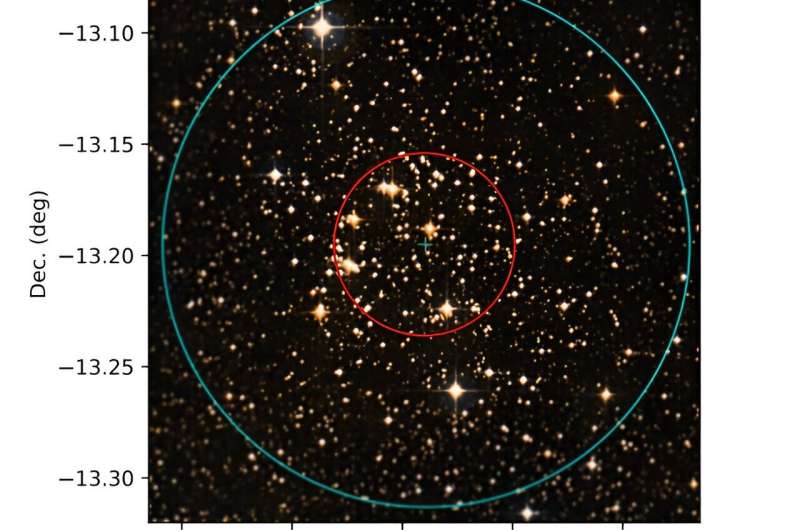March 13, 2024 report
This article has been reviewed according to Science X's editorial process and policies. Editors have highlighted the following attributes while ensuring the content's credibility:
fact-checked
preprint
trusted source
proofread
Astronomers perform a comprehensive study of the young open cluster NGC 2345

Using the Himalayan Chandra Telescope (HCT) and ESA's Gaia satellite, Indian astronomers have conducted a comprehensive study of a young open cluster designated NGC 2345. Results of the study, presented March 7 on the preprint server arXiv, shed more light on the properties and nature of this cluster.
Open clusters (OCs), formed from the same giant molecular cloud, are groups of stars loosely gravitationally bound to each other. So far, more than 1,000 of them have been discovered in the Milky Way, and scientists are still looking for more, hoping to find a variety of these stellar groupings. Studying OCs in detail could be crucial for improving our understanding of the formation and evolution of our galaxy.
NGC 2345 (or OCL 575) is a young galactic OC with a low metallicity, located most likely some 10,000 light years away within the disk of the Milky Way galaxy. The cluster is known for its relatively high fraction of Be stars, and also contains blue and red supergiants, which makes it an interesting target for studying stellar evolution.
That is why a team of astronomers led by Kuldeep Belwal of the Indian Center for Space Physics in Kolkata, India, decided to investigate NGC 2345 in detail. For this purpose, they employed HCT's Hanle Faint Object Spectrograph Camera (HFOSC) and analyzed the data from Gaia's Data Release 3 (DR3). The study was complemented by datasets from the Two Micron All-Sky Survey (2MASS) and the American Association of Variable Star Observers (AAVSO) Photometric All-Sky Survey (APASS).
"For the first time, we analyzed the cluster members to determine the fundamental parameters of cluster NGC 2345," the researchers wrote in the paper.
Belwal's team managed to identify 1,732 most probable member stars of NGC 2345 with membership probability higher than 70%. Based on this sample, the astronomers were able to obtain fundamental and structural properties of the cluster.
The distance to NGC 2345 was measured to be approximately 9,100 light years. Adopting this distance, the radius of the cluster was calculated to be 33.8 light years. The core and tidal radius of NGC 2345 were estimated to be 10.3 and 64.9 light years, respectively.
The study found that NGC 2345 has a mean proper motion of -1.34 and 1.35 mas/year in right ascension and declination, respectively. The cluster has a reddening at a level of 0.63 mag and its age was determined to be 63 million years.
The astronomers found a signature of mass segregation based on slopes in the core, halo, and overall regions of NGC 2345. Moreover, it turned out that the dynamical relaxation time for NGC 2345 is larger than the cluster's age, which confirms an ongoing mass segregation. The researchers estimate that the cluster will be dynamically relaxed after 100 million years.
The authors of the paper also investigated the motion of NGC 2345 in the Milky Way. As a result, they found that the cluster is moving in a circular path and has not yet completed a single orbit around the Galactic Center.
More information: Kuldeep Belwal et al, Exploring NGC 2345: A Comprehensive Study of a Young Open Cluster through Photometric and Kinematic Analysis, arXiv (2024). DOI: 10.48550/arXiv.2403.04532
Journal information: arXiv
© 2024 Science X Network




















